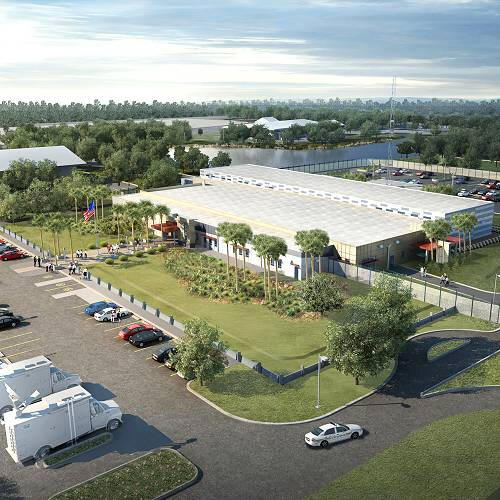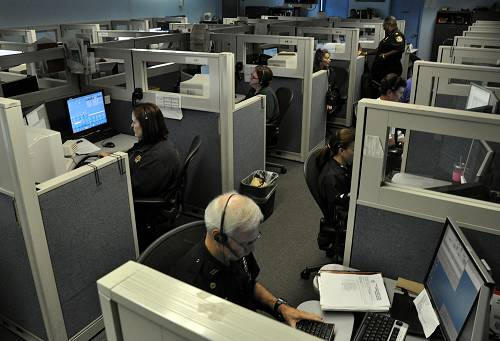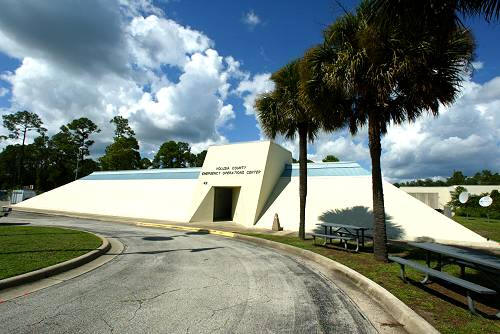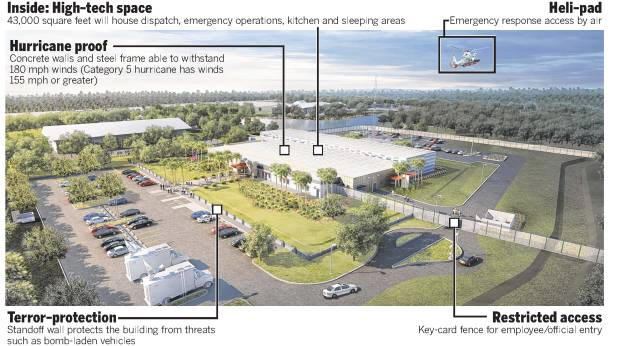Volusia County has plan, money in bank for new emergency operations center
Date Added: October 23, 2011 3:00 pm
Volusia County has plan, money in bank for new emergency operations center
By ANDREW GANT, Staff Writer
October 23, 2011

Aerial rendering of Volusia County's soon-to-be-built emergency operations center,
which is supposed to go under construction in January. (Schenkel Shultz)

Emergency operations dispatch is currently handled in two different communications centers. (N-J | Peter Bauer)

The 35-year-old operations center, which looks like a bunker, is 9,000 square feet. The new facility is 43,000. (N-J | Peter Bauer)

New Digs
Volusia County is building a new emergency operations center. Some features, according to the county:
· Concrete walls and a steel frame rated for 180 mph winds (a Category 5 hurricane is 155 mph and higher)
· A helicopter pad
· A 70-foot backup radio tower (the current one is 50 feet)
· A key-card fence surrounding employee and official access
· A "standoff wall" in the front to protect the building from, for example, a bomb-laden vehicle
· Multiple meeting rooms, a kitchen and bunk rooms that'll often be used to host training sessions
DAYTONA BEACH -- At some point, most people who've been in for an extended stay in Volusia County's "situation room" -- usually during a hurricane or wildfire -- use the same words to describe it:
Cramped. Crowded. Close.
"It was built like a tank," County Councilman Andy Kelly said of the county's 35-year-old emergency operations center, sequestered off U.S. 92 west of Daytona Beach. "It was built to protect those who are important to taking care of emergencies, so they can sit there and know they're protected. So it felt like a bunker."
That hunkered-down atmosphere is going to change soon. As Volusia's approach to handling emergencies moves toward a streamlined consolidation, officials say a bigger, better, newer emergency operations center will only help.
"It addresses all of our needs for emergency management for the future," County Chair Frank Bruno said about the plan for the 43,000-square-foot replacement, a long-dreamed-of EOC about five times bigger than the current one. "It gives us a lot of opportunities we don't have right now."
The project, a crucial step in Volusia's quest for a unified system that handles all its major and minor crises, will cost about $20 million.
It'll be paid for in cash. While the existing facility was built with federal grant money, today's version has no state or federal grants funding it. The county has been setting aside money from the general fund since 2005, spokesman Dave Byron said, and it has been earning interest the whole time. Today, the fund contains the entire $20 million.
"No question, this is a project that's been on the drawing board for a long time," Byron said. "It's been there for several years, going way back."
The County Council approved a new EOC in November 2009, part of a $30 million package that included projects at the jail and a remodeling of the existing bunker. The $20 million price tag includes design -- which is complete -- construction and furniture. The county expects to break ground in January, finish in December 2012 and open for business in March 2013.
The site on Tiger Bay Road, just west of Indian Lake Road, is central to the county's consolidation of emergency services.
Today, even after a recent consolidation, the county's dispatchers work out of two different centers. Volusia County Sheriff Ben Johnson said bringing dispatchers together under one roof will make them work more efficiently.
"With better working conditions, it's always better for your employees," Johnson said, "and you get better productivity."
The building's call room will have 60 consoles for the county's 125 dispatchers, and sound-deadening fabric to keep conversations where they belong.
Signal repeaters will give cellphones reliable service -- unlike in the current EOC, which is a dead zone.
The architect, Orlando-based Schenkel Shultz, has recently designed similar projects in Citrus and St. Lucie counties -- at 40,500 and 27,000 square feet, respectively. The construction contractor, Ajax Building of Jacksonville, is slated to present a final contract and a guaranteed maximum price to the council in December.
Around the middle of October, Ajax will send out about 35 bid packages to subcontractors who'll do the framing, concrete, mechanical and other work. Jerry Brinton, the county's director of engineering and construction, said the county is working closely with Ajax to make sure qualified local contractors are invited to bid.
The finished product will have the square footage of about nine NBA basketball courts -- accommodating an operations room that holds 60 officials, a County Council liaison office, a citizens information center, a HAM radio center, a media broadcast room, a kitchen, and bunk areas for both men and women.
The bunk areas will be used as training rooms most of the time. Public Protection Director Mike Coffin said county often trains cities, businesses and other groups on how to handle emergencies, and that training will improve in the new facility.
Fiber-optics, he said, will send more information out of the building, and faster. And TV news crews will actually be able to hook into the facility, which they can't do today.
"We've upgraded the technology in our current EOC in the past 35 years, but we're still stuck with some of that (old) technology," he said.
Council Vice Chair Pat Northey said the increased space will improve the county's emergency response because workers will actually get good rest. (More than one county official recalled people sleeping on and under desks during past crises.)
"I think that's a critical improvement," Northey said. "We would go out there and some people would be there, almost live there 24-7. Trying to find a quiet place to get a couple hours sleep was impossible. This changes that."
The old, 9,000-square-foot facility has effectively handled emergencies like the triple hurricanes of 2004 and the wildfire outbreak of 1998. But Timber Weller, a wildfire mitigation specialist with the state Division of Forestry, said an opportunity to expand facilities generally means better preparation.
"It can get that bad, and it will again," Weller said. "Whether it's a hurricane or a fire or some other type of disaster. Every so often, some area gets overwhelmed, and anything we can do between now and then to raise the level of security, safety is a benefit. It's worth doing."
